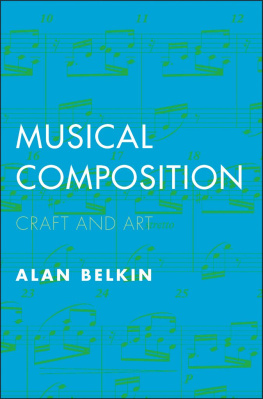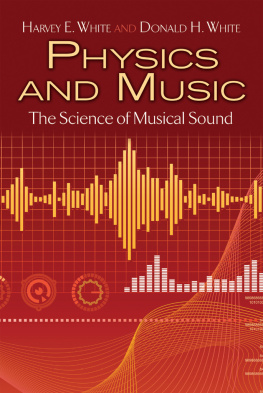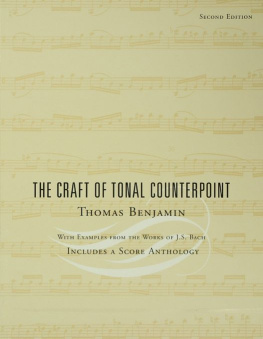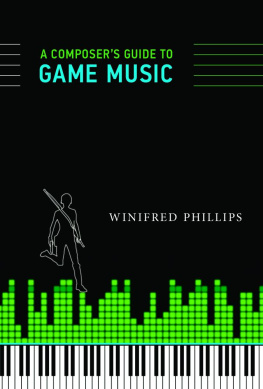MUSICAL COMPOSITION
MUSICAL COMPOSITION
CRAFT AND ART
ALAN BELKIN
Yale UNIVERSITY PRESS
NEW HAVEN & LONDON
Published with assistance from the foundation established in memory of Philip Hamilton McMillan of the Class of 1894, Yale College.
Copyright 2018 by Alan Belkin.
All rights reserved.
This book may not be reproduced, in whole or in part, including illustrations, in any form (beyond that copying permitted by Sections 107 and 108 of the U.S. Copyright Law and except by reviewers for the public press), without written permission from the publishers.
Yale University Press books may be purchased in quantity for educational, business, or promotional use. For information, please e-mail (U.K. office).
Set in Meridien and Futura type by Newgen North America.
Printed in the United States of America.
Library of Congress Control Number: 2017956623
ISBN 978-0-300-21899-2 (paperback: alk. paper)
A catalogue record for this book is available from the British Library.
This paper meets the requirements of ANSI/NISO Z39.48-1992 (Permanence of Paper).
10 9 8 7 6 5 4 3 2 1
CONTENTS
ACKNOWLEDGMENTS
First and foremost, my thanks to Andrew Schartmann, who encouraged me to write this book and to propose it to Yale University Press. He also made numerous detailed and perceptive comments on the first draft of the text.
Matthew Lane also spent many hours carefully commenting on the entire book in great detail; his numerous suggestions were always specific and constructive.
Maxime Samarov read the book from cover to cover and had many useful things to say, both musical and pedagogical.
Sylvain Caron commented perceptively on several chapters.
Michel Edward and Eric Jones-Cadieux gave me useful suggestions for examples from film and video-game music. Eric also took care of the many copyright requests and permissions for the twentieth-century examples.
Thanks to Maxime Goulet for explaining to me various particularities of music for video games, and also for giving me some intriguing ideas for exercises relevant to composers aiming to compose for video games and for films.
I am grateful to Nikola Miletenko and Thomas Goss for carefully proofreading the manuscript. Thanks to Fred Kameny for the index.
My best friend, Charles Lafleur, was a constant source of encouragement and thoughtful reflection while this project was underway. Both are enormously appreciated.
Thanks to Sarah Miller, Ash Lago, Harry Haskell, and the rest of the team at Yale University Press for their help in bringing this project to completion.
There are too many people to name who have contributed to my ideas about composition and composition pedagogy over the years, but I really must at least mention my teachers at Juilliard, David Diamond and Elliott Carter, who set me on such an interesting path.
Obviously, whatever weaknesses remain are mine alone.
INTRODUCTION
Teaching musical composition today has become a very complicated endeavor, owing to the students unprecedented variety of needs, interests, and backgrounds.
Overall, there are three broad categories of students studying musical composition at the undergraduate level: those aiming to compose concert music; those aiming at a career writing functional music for film, theatre, TV, video games, publicity, and so forth; and those whose main interest lies in theory or musicology, but who nonetheless want to have some insight into a composers point of view.
Making the teachers problem even more complex, above and beyond these disparate needs, the concert music of the past century has seen an unprecedented level of stylistic fragmentation. A composer of concert music could be writing in a hyper-complex style, like that of Brian Ferneyhough, or applying electro-acoustic techniques to harmonic spectra, like Tristan Murail, or else writing somewhat minimalist, tonal music, like John Adams. Even popular music today encompasses many different styles. How can one teach composition in a way that effectively addresses all these different needs?
Existing composition textbooks either focus exclusively on the classical repertoire or else simply catalog various more or less recent stylistic trends, with short chapters devoted to each one.
Arnold Schoenbergs Fundamentals of Musical Composition remains the best model of the former type, and it still contains much useful material, as well as a host of examples, with many useful comments by the author.
The other kind of book focuses on what is distinct and unusual about each new style. While certainly of interest to a contemporary composer, this approach is of limited use to someone who wants to acquire more widely
In this book I attempt to reconcile the varied needs listed above with an approach that is style-neutral, and that focuses on craft.
Despite their obvious differences, most kinds of music heard today share certain formal requirements that grow out of how music is perceived. For example, even though film music normally follows an extramusical, narrative story line, a film composer still needs to know how to compose a convincing transition between music of differing characters. Music for an ad campaign needs an effective beginning, so as to quickly attract the listeners attention, and so on. As these examples show, there is a pressing need to teach composition today in a way that is stylistically flexible, but at the same time helps the young composer to master the skills required to respond to the musics formal requirements.
Over thirty-five years of composition and composition teaching, I have tried to find, and to focus on, general principles that are not limited to one style of music. The result is this book. The common principles laid out here have rarely, if ever, been explicitly discussed as such, and certainly not all in one place, in a logical pedagogical sequence, with exercises and examples. This is the book I wish had been available to me as a student.
Some of the ideas here germinated out of passing remarks by my own composition teachers, David Diamond and Elliott Carter. Most of them, however, came simply from regular observation of great music that I admire. In a sense, they were attempts to answer questions I myself had about what exactly makes great music work as well as it does. Other notions gradually became clear to me during years of trying to teach many different kinds and levels of students as constructively as possible.
These principles are certainly not of my own invention. Despite the fact that they are almost never referred to in composition textbooks, most successful composers have clearly been aware of them on some level for hundreds of years: they are everywhere to be seen in the best music of the western tradition.
ASSUMPTIONS
Even attempting to focus on general principles in a way that is applicable to multiple styles, I do make certain assumptions in this book about the nature of music. Some of them can of course be debated, but it is impossible to teach composition at all without at least some minimal consensus about what the word implies.
I assume that powerful emotional communication is an important goal of music. I also assume that some means are more effective than others in reaching this goal. Often the difference between a successful piece and a weak one is that in the latter there are aspects of the music that distract from, or even contradict, the desired musical character. This is because beginning students do not always realize the significance of all of their choices. For example, imagine the beginning of Beethovens Fifth Symphony played very slowly, an octave lower, on a marimba. The enormous dramatic drive of the famous fate motif would completely disappear, even though the pitches and the note values would be correct. This may seem like a trivial example, but long experience with student work has shown me that dimensions of the music like register, tempo, dynamics, and timbre are often not accorded enough attention, although they contribute enormously to the quality of the final expressive result. If the young composer makes the wrong choices in these areas, the musics character will suffer greatly. In this book, I will try to pay more or less equal attention to pitch and to these other aspects of the music.
Next page










